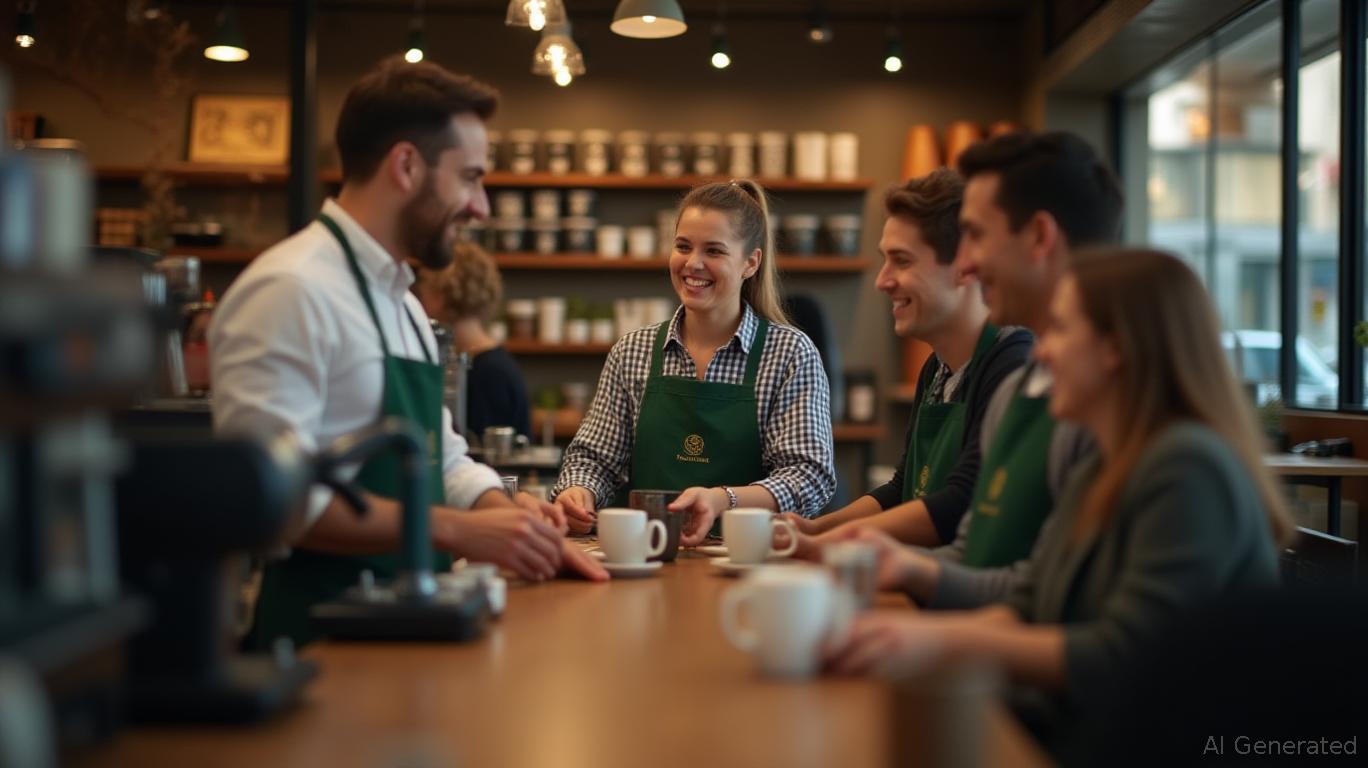Starbucks' Green Apron Rollout: A Strategic Gamble on Operational Efficiency and Customer Experience
Starbucks' accelerated rollout of its Green Apron staffing model—now set to cover all North American stores by summer 2025—marks a bold pivot toward operational reinvention. The initiative, central to CEO Brian Niccol's “Back to Starbucks” turnaround strategy, aims to reinvigorate sales growth by prioritizing in-store hospitality, reducing wait times, and enhancing customer engagement. But can this shift from automation to human-centric service overcome near-term financial hurdles and deliver long-term value for investors?

The Green Apron Model: Operational Efficiency as a Growth Lever
The Green Apron model, first tested in 700 stores, has already demonstrated measurable gains. Key components include:
- Technology-Driven Order Sequencing: Algorithms reduce wait times to under four minutes, a target now achieved by 75% of pilot stores during peak hours.
- Specialized Staff Roles: Dedicated baristas manage drive-thru lanes, while urban stores add staff to handle mobile orders, optimizing labor allocation.
- Hospitality Revival: Personal touches like handwritten notes, ceramic mugs, and a consistent dress code aim to rekindle the brand's community-centric roots.
These changes have not only streamlined operations but also improved employee satisfaction, with turnover rates dropping to a record low below 50%. Starbucks' decision to halt its 2022 automation efforts (e.g., the Siren System) underscores its belief that human-driven service is key to differentiation in a crowded coffee market.
Financial Reality: Growth vs. Margin Pressure
While operational metrics are promising, Starbucks' Q2 2025 results highlight execution challenges. Global net revenue rose just 2% to $8.8 billion, missing Wall Street expectations. North American comparable store sales fell 1%, driven by a 4% decline in transactions, though average ticket prices rose 3%.
The margin squeeze is stark: North American operating margins contracted 640 basis points to 11.6%, as labor costs surged to fund the Green Apron rollout.
slashed 1,100 corporate roles to offset expenses, but barista hiring (at $30/hour including benefits) remains a drag. Analysts note the stock's 11% five-year gain lags the S&P 500's 88% rise, reflecting investor skepticism about the turnaround timeline.Why This Could Pay Off Long-Term
- Customer Experience as a Revenue Engine: Reduced wait times and personalized service could drive repeat visits. Starbucks' focus on in-store community-building contrasts with rivals like Dunkin', which prioritize speed over ambiance.
- Global Scalability: While the model is currently North America-focused, Starbucks' success in replicating it internationally—particularly in China, where comparable store sales flatlined in Q2—could unlock growth.
- Unit Economics: The Clover Vertica coffee brewer (now in 70% of stores) and labor efficiency algorithms may lower per-store costs over time, improving margins.
Risks and Uncertainties
- Execution Risks: Scaling the model across 18,000 stores without compromising quality is daunting. Unions and employee retention could become flashpoints.
- Market Competition: Competitors like Tim Hortons and regional chains are aggressively expanding, squeezing Starbucks' market share.
- Economic Sensitivity: Higher labor costs may persist in a tight job market, limiting near-term profitability.
Investment Thesis: Hold for Now, but Watch for Turnaround Signals
Starbucks' stock trades at ~20x trailing earnings—a premium to its five-year average but justified if the Green Apron model drives a sustained sales rebound. Investors should look for:
- Q3 2025 Results: Signs of transaction growth in North America and China.
- Margin Stabilization: Evidence that labor investments are paying off in reduced wait times and higher customer satisfaction.
- Global Rollout Progress: Updates on how the model adapts to international markets.
For now, hold the stock until clearer signs of operational and financial alignment emerge. The Green Apron gamble could redefine Starbucks' relevance, but patience—and a tolerance for short-term pain—is required.
Final Take: Starbucks' strategic bet on service excellence is bold but fraught. Investors should prioritize the company's ability to convert operational improvements into sustained revenue growth over the next 12–18 months.

Comments
No comments yet